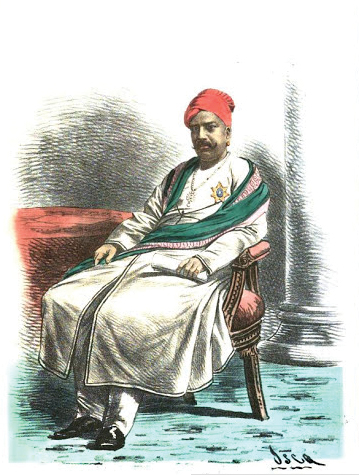Registered with the Registrar of Newspapers for India under R.N.I 53640/91
Vol. XXVII No. 8, August 1-15, 2017
CHARIVARI – 4
Sriram V
THREE TIMES A DEWAN

The Indian Charivari series does not include many Indians, its attention being largely on colonial administrators. Among the few who made it is Tanjore Madhav Rao. He could clearly not be overlooked, for his record, when the Charivari was under preparation, was nothing short of trailblazing. He had just then completed his tenures as Dewan of two princely states – Travancore and Indore – and was embarking on the third – Baroda. And none of these was placid tenure. In each case, he took over a State that was in a shambles and by the time he left, they were upheld as models of administration.
Madhav Rao was born in 1828 in Kumbakonam in an aristocratic Maratha family. His ancestors had been of service to various rulers and the East India Company. Uncle Rai Raya Rai Venkata Rao and father Ranga Rao had been Dewans of Travancore. Madhav Rao studied at the Madras High School headed by E.B. Powell, which would later become the Presidency College. Having graduated as a Proficient, he taught Maths for some time in the school before joining government service and being posted to Tanjore. He later became the tutor of the young prince, Ayilyam Tirunal, in Travancore. The ruler, Uthram Tirunal, however, was quick to notice his talents and he was given appointments in the Treasury. In 1858, at the age of 30, Madhav Rao became Dewan and addressed himself to the task of reducing Travancore’s public debt. It helped that the orthodox Uthram Tirunal passed away in 1860, and was succeeded by the liberal-minded Ayilyam, Madhav Rao’s ward. Several enlightened policies were implemented and, by 1863, the State’s revenues were in surplus.
Differences of opinion cropped up between the ruler and the prime minister and, in 1872, Madhav Rao resigned and settled in Mylapore, building the palatial Madhav Bhavan on Luz Church Road, now a part of the MCtM School. But he was not to spend his remaining years in idleness. He was invited to Indore as Dewan and there too he worked wonders, overcoming the ruler’s reluctance to introduce railways. He also put Indore on the industrial map, setting up mills.
In 1875, the Government of India requested that he take over as Dewan of Baroda. The ruler, Malhar Rao had been deposed on grounds of maladministration and brought to Madras. Jamna Bai, the wife of the previous ruler, Khande Rao, had just adopted a young boy who was a minor. Madhav Rao moved there and, as the Charivari puts it, worked to “bring order out of chaos.” Under his guidance, the State prospered and the boy, Sayaji Rao Gaekwad III, would blossom as an enlightened prince. Madhav Rao was instrumental in the ruler marrying Chimnabai, a princess of Tanjore. A part of the dowry was a family of dancers and musicians, all of whom would settle in Baroda and give rise to the Tanjorekar School of South Indian music and dance. The marriage was a happy one but short-lived as Chimnabai died in childbirth. Sayaji Rao married again, this time a local chieftain’s daughter, who took on the name of Chimnabai II. But it was the line from the Tanjore princess that would eventually succeed Sayaji Rao.
The Charivari account ends in 1875. But we do know of Madhav Rao’s later years. By 1882 the ruler and Dewan would fall out with each other and Madhav Rao returned to his Mylapore home. He passed away there in 1891.
During the course of such a successful life, Madhav Rao received many honours. Chief of these was his individual title of Rajah, and his being made a Knight Commander of the Order of the Star of India. His portrait was executed by Raja Ravi Varma and now hangs in Laxmi Vilas Palace, Baroda. Trivandrum’s famed Statue Junction gets its name from a statue of Madhav Rao, long in planning but erected only in 1891, the year he died.

